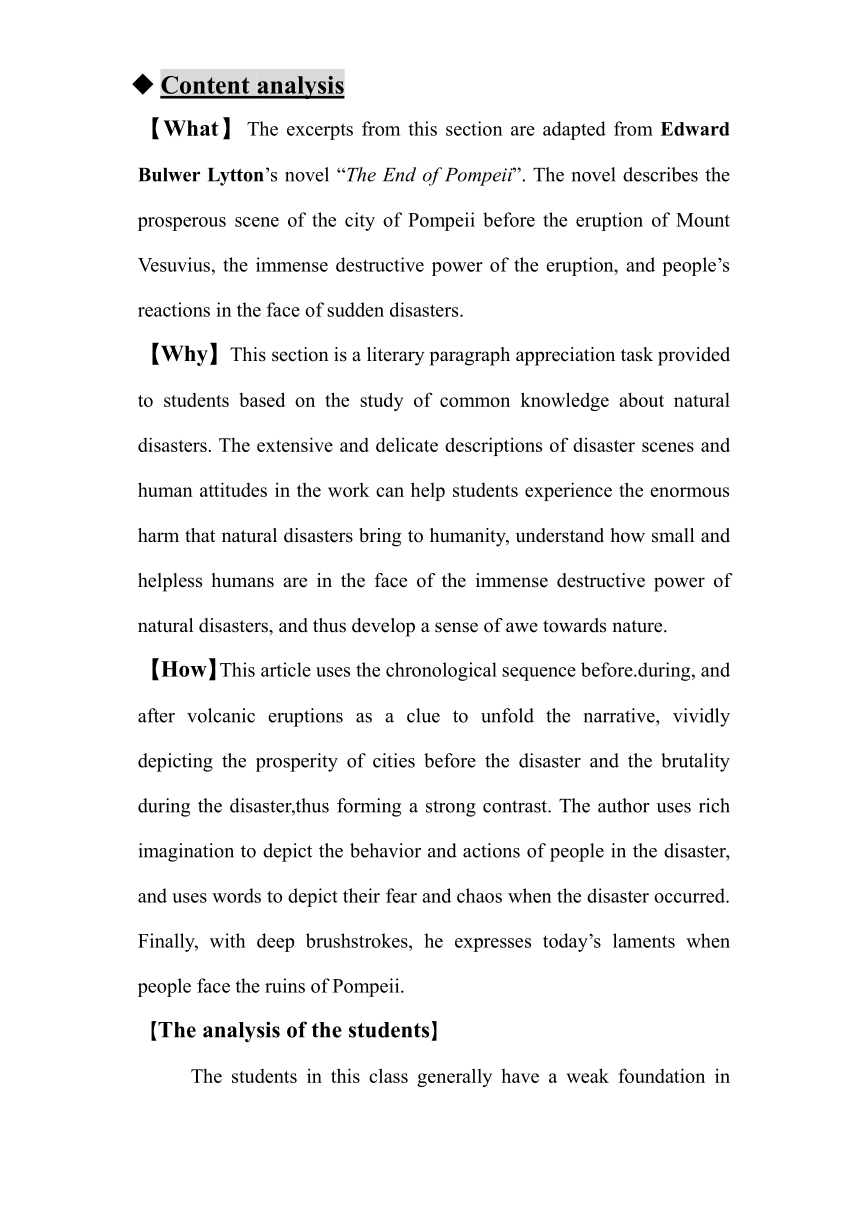
Content analysis 【What】The excerpts from this section are adapted from Edward Bulwer Lytton’s novel “The End of Pompeii”. The novel describes the prosperous scene of the city of Pompeii before the eruption of Mount Vesuvius, the immense destructive power of the eruption, and people’s reactions in the face of sudden disasters. 【Why】This section is a literary paragraph appreciation task provided to students based on the study of common knowledge about natural disasters. The extensive and delicate descriptions of disaster scenes and human attitudes in the work can help students experience the enormous harm that natural disasters bring to humanity, understand how small and helpless humans are in the face of the immense destructive power of natural disasters, and thus develop a sense of awe towards nature. 【How】This article uses the chronological sequence before.during, and after volcanic eruptions as a clue to unfold the narrative, vividly depicting the prosperity of cities before the disaster and the brutality during the disaster,thus forming a strong contrast. The author uses rich imagination to depict the behavior and actions of people in the disaster, and uses words to depict their fear and chaos when the disaster occurred. Finally, with deep brushstrokes, he expresses today’s laments when people face the ruins of Pompeii. 【The analysis of the students】 The students in this class generally have a weak foundation in English, mainly reflected in their limited vocabulary, lack of systematic grammar knowledge, and weak writing ability. However, in previous courses, we have learned vocabulary and content related to various natural disasters, laying a foundation for the content related to volcanic eruptions in this lesson. It can also help students better understand the content of this article, thereby deepening their understanding of human reactions and feelings in the face of natural disasters 【Teaching aims】 1.Grasp the background information of Pompeii and Mount Vesuvius; 2. Comprehend the plot and appreciate the descriptive language; 3. Make up a short story based on the pictures; 【Teaching focus】 1. Grasp the background information of Pompeii and Mount Vesuvius; 【Teaching difficulties】 1. Comprehend the plot and appreciate the descriptive language; 2. Make up a short story based on the pictures; TEACHING PROCEDURE Part 1 Lead-in Teacher makes a Wechat call to his friend, Da Zhuang, who is visiting the city of Pompeii and asks about something of the city. Let the ss. enjoy a video from Da Zhuang and have a rough understanding of the city of Pompeii. Part 2. Pre-reading Ask the ss. to read the introduction of the writer Edward Bulwer-Lytton and the city of Pompeii. After finishing read it , answer the following questions: Question 1: What can we learn from this introduction 1). The city of Pompeii was completely destroyed by the volcanic eruption in the year _____. 2). Pompeii was systematically unearthed in _____. 3).Today Pompe ... ...
~~ 您好,已阅读到文档的结尾了 ~~

